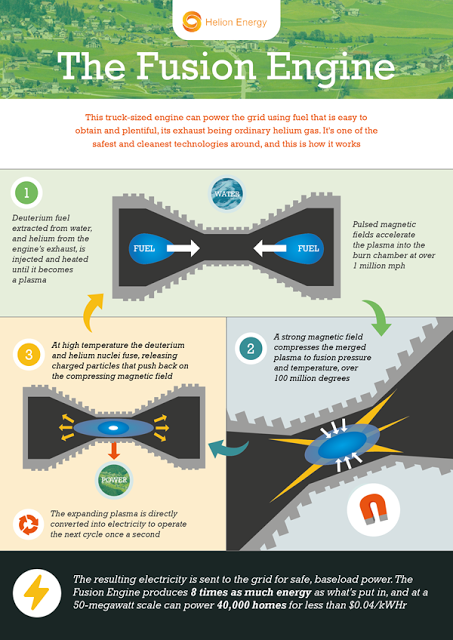I answered a Quora question about How close are we to nuclear fusion ?
The popular question is when will we have commercial nuclear fusion that has a significant impact on the energy production of the world.
Updated Prospects for Commercial Nuclear Fusion
I have had several articles summarizing the prospects for commercial nuclear fusion
The ITER project and the national ignition projects are decades away according to their own timelines. They are really counting on advanced superconductors to reduce the size and improve projected cost and performance.
So the near term possibilities are the smaller projects.
Helion Energy got funding increased towards tens of millions instead of a few million. John Slough works out of the University of Washington. If all proceeds on schedule then a Helion Energy machine that that proves commercial energy gain would be a 50 Megawatt system built in 2019. $200 million will be needed for the commercial pilot plant. The plan would be to start building commercial systems by 2022. I would give Helion the edge in terms of odds to be first to succeed. However, just like nuclear fission, their can be more than one successful technology. Different countries can adopt different or even multiple designs. There will also be nuclear fusion for space propulsion (actually easier than beating coal or natural gas for energy production. Run a fusion propulsion for minutes or hours and it is better than ion drive. Nuclear fusion will have a lot of applications that will need different designs.
Prototypes every two years
LPP Fusion (Lawrenceville Plasma Physics) – the target is to make LPP Fusion with a commercial system 4 years after net energy gain is proved. The hope is two years to prove net energy gain. Then 2019-2022 for a commercial reactor (2022 if we allow for 3 years of slippage). They could lower energy costs by ten times.
LPP Fusion is very public about their research. They are minimally funded with a few million. They are trying to get tungsten and berrylium anodes and cathodes to work for their dense plasma focus design. Think of an advanced spark plug design. They are trying to get a handle on contamination from the firings. They are looking to coat their chamber with titanium. They have to up the amperage to about 3-4 megaamps.
General Fusion- has a steam punk like design with giant pistons striking a sphere with molten metal and plasmoids. They have Jeff Bezos funding as well as Canadian and Malaysian government. 2023 (targeting 4 cents per kwh)
Tri-Alpha Energy (previously talked about 2015-2020, but now likely 2020-2025). They have best funding of the venture funded fusion. They have raised over $150 million.
Lockheed Compact Fusion has a target date of 2024 and made big news recently with some technical details and an effort to get partners. Not much news out of Lockheed. Experts have criticized the technical details that they released. Outsiders think that they are too optimistic about how small they can make it by several factors.
There are several other projects.
IF they all stall out or do not deliver anywhere near their target dates, then I think the progress in high energy rapidly pulsed lasers will be where nuclear fusion is produced. Lasers keep improving by orders of magnitude and the pulsing also has rapid improvement.
It has been proposed for space propulsion but I think it would work for energy generation.
There was also a claim of ultradense deuterium generated fusion.
If no nuclear fusion works out and the LENR/cold fusion take a lot longer then I expect the molten salt nuclear fission to transform energy. In particular the Terrestrial energy reactor.
China is also working on supercritical water reactors that along with factory production efficiency and massive industrial scale could provide lower cost energy.
Really good solar with really good batteries scaled up by 100 times or more could also be transformative.

Brian Wang is a Futurist Thought Leader and a popular Science blogger with 1 million readers per month. His blog Nextbigfuture.com is ranked #1 Science News Blog. It covers many disruptive technology and trends including Space, Robotics, Artificial Intelligence, Medicine, Anti-aging Biotechnology, and Nanotechnology.
Known for identifying cutting edge technologies, he is currently a Co-Founder of a startup and fundraiser for high potential early-stage companies. He is the Head of Research for Allocations for deep technology investments and an Angel Investor at Space Angels.
A frequent speaker at corporations, he has been a TEDx speaker, a Singularity University speaker and guest at numerous interviews for radio and podcasts. He is open to public speaking and advising engagements.





Comments are closed.